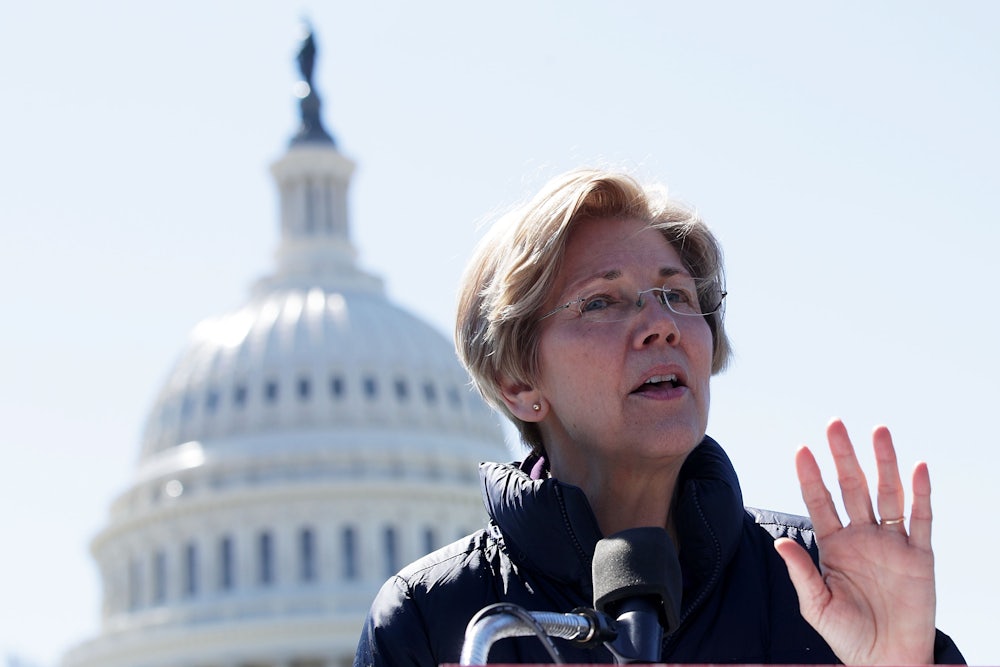On the last day in January, an angry horde, reportedly numbering in the thousands, amassed outside the Brooklyn home of Chuck Schumer, the Senate minority leader. Liberal and left-wing activists had come to scold their senator—the de facto leader of congressional resistance to Donald Trump—for voting to confirm three of the president’s cabinet nominees, and for offering to work with him on an infrastructure package. Schumer was being put on notice, declared Jonathan Westin, executive director of New York Communities for Change: “The Democratic base wants full-on resistance to everything this president does.”
In the early days of Trump, even liberal favorites Elizabeth Warren and Sherrod Brown were coming under fire, after they voted in committee to approve Ben Carson as housing secretary. “It’s a shame that Warren just decided not to run for president in 2020,” quipped Ian Millhiser of the Center for American Progress. The only acceptable stance for Senate Democrats to take, Salon’s Amanda Marcotte added, is “Just say no.”
Ever since Trump’s election, that’s been the consensus view on the left. Senators got the message loud and clear. In March, when Carson’s nomination came before the full Senate, Warren voted against him. Later that month, Schumer and four other top Democrats sent a letter to Majority Leader Mitch McConnell threatening the ultimate form of obstructionism: a government shutdown if Trump includes funding for a border wall in the supplemental budget needed to keep federal operations running past April.
Those who advocate a “just say no” approach will tell you it’s not merely a moral imperative: It’s also the smartest way for Democrats to stage a comeback. After all, it replicates the cutthroat-but-genius strategy that McConnell used to stifle Barack Obama. As New York columnist Jonathan Chait explained, “McConnell’s strategy of withholding bipartisan support and forcing the majority party to have complete responsibility for all outcomes is an effective one for the opposition. That’s the best model.”
Actually, the model that Chait refers to is a myth. Yes, the way McConnell obstructed Obama helped position Republicans to come roaring back in 2010 and beyond. But he didn’t do it with “full-on resistance to everything.” McConnell is too crafty for that. And Schumer and the Democrats should be, too.
Let’s look at what McConnell and the Republicans actually did in 2009. This was the year, keep in mind, after Obama’s election had shocked and terrified so many of their constituents. But McConnell extended the traditional deference to Obama’s cabinet nominees, approving some of them—including Hillary Clinton for secretary of state—with nearly unanimous backing. (Only two Republican senators opposed the she-devil of the right.) Nor did McConnell try to block all of Obama’s early initiatives. During Obama’s first four months in office, significant numbers of Republicans got behind bills to expand the AmeriCorps program, crack down on mortgage lenders, enforce truth in lending, and prevent rural foreclosures. When Obama submitted his supplemental budget to keep the government running that spring, 38 of 40 Republican senators voted yes.
The Republican opposition to Obama was actually quite selective. McConnell highlighted GOP opposition to two bills: the huge stimulus package and the Affordable Care Act. The minority also stood firm against smaller proposals that involved greater spending or regulation. But they didn’t squawk about everything Obama tried to do. That was the Tea Party’s job. Instead, GOP senators drew red lines on core symbolic issues for their base, while tapping into Middle America’s skepticism about big government. And when unemployment continued to rise, from 6.8 percent in November 2008 to 9.8 percent in November 2010, McConnell’s party was poised to make its case that Obama was steering the economy in exactly the wrong direction.
McConnell knew that total obstruction was a dead end. The Republicans had tried it in 1995–96, when Newt Gingrich lost his shutdown showdown with President Clinton, who sailed to re-election. When Tea Party Republicans tried it again in 2013, shutting down the government in a doomed effort to defund the Affordable Care Act, the strategy was a bust. A majority of Americans blamed the GOP for obstructionism, and the party would have paid a steep price in the 2014 mid-terms, if not for the glitch-filled rollout of Obamacare. McConnell’s steady and focused opposition had primed voters to turn against Democrats. Republicans had lost the ACA battle, but they’d won the political war.

Democrats who can’t stomach the slightest overture to Donald Trump should also look back at their own party’s track record of successful opposition. In 2005, Republicans had just re-elected George W. Bush, and they controlled both houses of Congress by majorities similar to the ones they currently enjoy. Hard as it is to believe, many Democrats loathed Bush as much as they now detest Trump. But the 44 Democrats in the Senate didn’t try to block all of Bush’s nominees and bills. Instead they used a strategy of selective opposition. Bush’s cabinet and agency appointees were routinely waved through on voice votes. Thirty-five Democrats voted for the Bush-Cheney energy plan, 18 for the bankruptcy bill, and 17 for the so-called Tax Increase Prevention and Reconciliation Act. But they held the line on a single proposal: Bush’s plan to partially privatize Social Security. And they closed ranks to obstruct a single nominee: John Bolton as ambassador to the United Nations.
They chose well. Democratic opposition to privatizing Social Security stirred up so much public opposition that Republicans in Congress didn’t even bring it to a vote. And their united front against Bolton, who symbolized the arrogance and folly of Iraq, prevented his confirmation. As unpopular as Bush was at the time, Democrats understood that it was wiser to fight his most destructive policies, not every one of them. Even though grassroots liberals cried “sellout” with some regularity, Senate Democrats cast the party as the one that cared about peace, and would go to battle for the aged and vulnerable. As a result, they swept the congressional races in 2006, rendering Bush virtually powerless. Two years later, they elected a president.
But isn’t Trump a whole different story? Doesn’t he present a threat to democracy that’s entirely unique in our history—and thus demands a level of stubborn, unflinching resistance that even Dubya did not?
Not yet, he doesn’t. Based on his campaign rhetoric, and on what he’s already tried to do as president, it’s clear that Trump is quite capable of leaving catastrophe in his wake. But he faces plenty of friction from his own Republican majorities in Congress, which will make it hard for him to do his worst. And Democrats should bear in mind that Trump’s election was a sign of discontent with both Clinton Democrats and Paul Ryan Republicans. He appealed to the dark side of the American soul, and his campaign was heavy on standard GOP fare about climate change, abortion, and illegal immigration. But he also championed remnants of New Deal liberalism, spoke to people’s genuine economic despair much like Bernie Sanders did, and pledged to create his own universal health program.
Trump’s victory was not merely a sign of an electorate gone mad; it was also a cry of dissatisfaction with the way that Democrats, as well as Republicans, responded to the Great Recession and its brutal aftermath. By peremptorily dismissing every Trump proposal, Democrats would be dismissing that part of the electorate that likes his stands on trade, manufacturing, runaway shops, and infrastructure. Democrats need to connect with those working-class voters, and they won’t do it by refusing even to try to team with him to stimulate the economy with the right kind of infrastructure plan, or to protect Social Security and Medicare from the Ryan Republicans.
Unfortunately, the Democrats can’t just pick a single issue on which to make their stand, like they did with Bush’s privatization plan. Trump’s first-term ambitions are far too broad for that. Schumer’s minority will likely go to the mat on climate change, financial deregulation, and the border wall. Their guiding principle should be that Democrats will fight any Trump initiative that betrays public expectations of what government owes its citizens. Accordingly, they should mount a national crusade, and use every blocking tactic at their disposal, to oppose the GOP plan to —“replace” Obamacare with a program that won’t guarantee affordable health insurance to all Americans.
To revive their fortunes and lay the groundwork for dispatching Trump in 2020, Democrats will, first and foremost, have to re-establish their reputation as the party that cares about ordinary Americans. This is where elections are won and lost. It’s where Obama bested Romney, with his talk of the “47 percent,” and it’s where Trump defeated Clinton, with her condemnation of the “deplorables.” Democrats who counsel universal intransigence to all things Trump must bear this in mind. The party needs to forge a new politics that, without rancor or scapegoating, resonates with the economic anxieties that both Sanders and Trump tapped into in 2016. The best way to do that isn’t to follow the path of all-out resistance. It’s to follow the path of smartest resistance.
